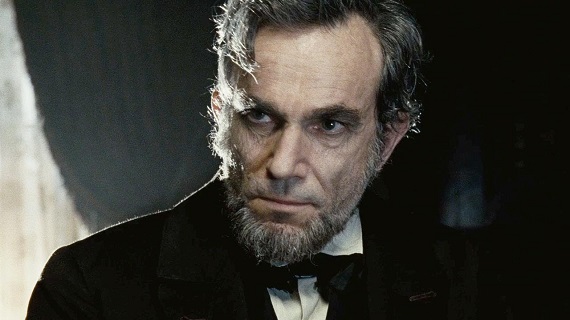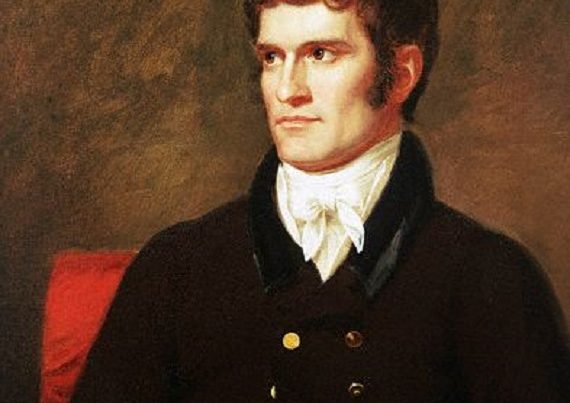
10. Spielberg’s Lincoln
(X) Spielberg’s Lincoln. Life is short. Although I am a devoted if amateur student of Hollywood’s treatment of the great American War of 1861-65, I intended to spare myself the ordeal of Spielberg’s Lincoln. However, the honoured editor of America’s bravest and best journal (Tom Fleming of Chronicles) instructed me to go. I have always found such instruction to be wise. And so, I bit the bitter pill or swallowed the bullet, or whatever, and went. You may regard me as having suffered in your behalf, Gentle Reader,and be relieved of the burden of attendance.
Daniel Day-Lewis portrays Lincoln, following in the footsteps of Walter Huston, Henry Fonda, Raymond Massey, Gregory Peck, and Sam Waterston—all better looking than the real thing. One side of Lincoln’s face was deformed, he had moments of doddering unconsciousness from having been kicked in the head by a horse, and, as everyone noted, his arms were disproportionately long, which led his accomplices to call him “the Ape” behind his back. But I suppose one should not complain about that—actors and actresses are always better looking than the real life people they mimic.
After all the praise lavished upon the Irishman Day-Lewis’s portrayal of Lincoln, I was surprised at how poor it was. The appearance is wrong. The accent is very wrong for a 19th century Midwesterner born and raised among people from the upper South. Worst of all, Lincoln is played with a strange diffidence such as no successful lawyer and politician ever had. It is like Jimmy Stewart with a beard and spectacles, the humble saint that many imagine Lincoln to have been. Nearly all testimony of the time disputes the tender Lincoln family relations that are presented early on to establish the gentle benevolence of the man. His wife and his children were considered nuisances by most of the people around them.
The film begins with a false portrayal of the battle of Jenkins Ferry, which was a victory by outnumbered (as usual) Confederates, that put an end to a major Union cotton stealing campaign. There was no massacre of black troops nor any massacre of Confederate prisoners by blacks in retaliation as is claimed. Most Northern soldiers would have slaughtered their black “comrades” before allowing them to slaughter Confederate prisoners. I suppose this invention makes a gratifying vicarious revenge fantasy for the leftist homosexual screenwriter. The 1st and 2nd Kansas Regiments (Coloured) are described inaccurately as cavalry. There were no black cavalry units in active service in the war, though sometimes infantry may have been mounted on mules. Northern soldiers would have balked at blacks riding while they walked. During the war black soldiers were mostly labor and garrison troops, and occasionally, as at Fort Wagner and the Crater, sacrificed in forlorn hopes to spare the lives of white Northerners. Ambrose Bierce, a frontline Union soldier for the entire war, said he never saw any black people except the servants and concubines of Union officers.
It reminds me of an Italian flick I once saw, in which a tall, handsome black American paratrooper drops in to liberate an Italian village. There were no black paratroopers and very few black combat units in World War II. The U.S. Army was as segregated as it was in the Civil War. There is no question that affirmative action is aggressively alive and well in entertainment. Black men are portrayed as proportionately more numerous than they were as combat troops in Vietnam and later wars, as well as more frequently than is likely as brilliant surgeons, scientists, philanthropists, admirals, judges, noble statesmen, and such.
The film shows Lincoln in friendly conversation with black soldiers who were veterans of Jenkins Ferry, though how they got to Washington from Arkansas is not explained. Such a scene is unlikely. Lincoln throughout his life had relatively little contact with black people. They were by law excluded from settling in Illinois. Some were run out of Springfield in Lincoln’s time and there was at least one lynching there after the war. He did receive a delegation or two at the White House, to whom he hinted that the best thing their people could do was to emigrate to some friendlier clime. He spoke to them. They were not allowed to reply. Lincoln, an earthy man of his time and place, adept at amusing the yokels around the cracker barrel, probably, like most Northerners then and later, used the n-word routinely. As Frederick Douglass observed, Lincoln was emphatically “the white man’s President.”
We are told that Lincoln had never accepted slavery, which is belied by both his legal and political careers. And that he had fought the war to end slavery, something which he denied repeatedly. The strangest thing about the film is that the producers chose to build it around the machinations leading to acquiring Congress’s two thirds vote for the Thirteenth Amendment emancipating the slaves. If I wanted to make an attractive dramatization of Lincoln there are many other events that I would choose: his adoption of “free soil” and the Republican party late in his career; the Cooper Union speech; his winning the nomination in 1860 over better-known men; the Fort Sumter crisis; the Emancipation Proclamation; the second inaugural.
Obviously, these makers of a film about Lincoln wanted the film to be all about slavery, requiring a basic perversion of accuracy. A number of authorities have pointed out that Lincoln did not play a very active a role in the Thirteenth. Nor at the time was it as important or decisive as portrayed. The presentation of the political and Constitutional issues is full of erroneous and presentistic assumptions and incoherent reasoning. There seems disinterest in the fact that Congress proposing the amendment was just that. The amendment still had to be ratified by three-fourths of the States. What did that mean when more than two-fifths of the states were fighting the Union or kept “loyal” only by the Army? And when Lincoln relied on the silly theory that they were still States though temporarily controlled by mobs of lawbreakers, while many in his party contended that the “rebellious” states were no longer states. Anyway, the question could not be settled until the war was over.
Besides, the amendment meant little. Confederate opinion had already accepted that slavery had been altered by the war and was willing to give up slavery in exchange for freedom from the invading tyrant. In the brief postwar period before harsh Congressional Reconstruction descended, the Southern states ratified the Thirteenth readily and breathed a sigh of relief at putting down the burden. The real issue left untouched by the Thirteenth was what would be the status in American society and law of the people thus freed.
But like so much of the treatment of The War we are subjected to, the charity for black people actually takes second place to the white-washing of Northern behavior, to safeguarding what Robert Penn Warren called “the treasury of virtue.” The amount of whitewash needed to keep up the fraud of a benevolent North far exceeds what was needed for Tom Sawyer’s fence.
Another Italian flick I saw (I waste a lot of time, even though life is short) purported to be a dramatization of Uncle Tom’s Cabin. In this film, a group of Catholic brethren are maintaining a fort deep in the South for the protection of runaway slaves. No such thing ever existed, nor would antebellum Southerners have allowed it for a day. Further, despite today’s Yankeeization of most American Catholics, the Roman Catholic Church never discountenanced slavery in the U.S. It generally disapproved of abolitionist agitation, and not only because most abolitionists were also virulently anti-Catholic. Not to mention that the Church lived comfortably for centuries with slavery in Latin America. The poet laureate of the Confederacy was Father Abram J. Ryan. Pio Nino sent a Missouri Confederate chaplain to preach against the Yankee recruitment of cannon fodder. Bishop Las Casas, the saintly prelate of the Spanish Indies, thought slavery was bad for Indians but good for black people.
Meanwhile,don’t reward Spielberg by buying an absurdly over-priced theater ticket. Instead, rent Gore Vidal’s Lincoln, a 1988 film with Sam Waterston and Mary Tyler Moore as the presidential couple. Unlike Hollywood moguls and writers, I know a little something about 19th century America, and I feel assured in telling you that Waterston and Moore are vastly more authentic Lincolns than the Irishman Day-Lewis and the Flying Nun, Sally Field. The portrayal of Lincoln is sympathetic but honest. You will learn some genuine American history rather than endure the fantasies of people who have remade that history in their own image.






